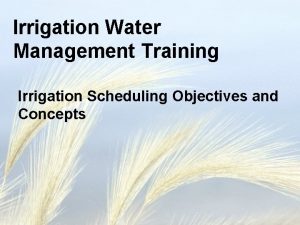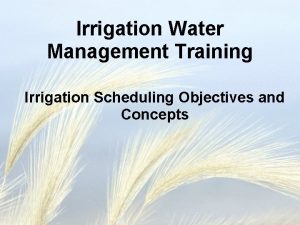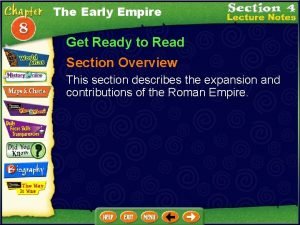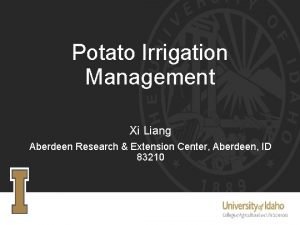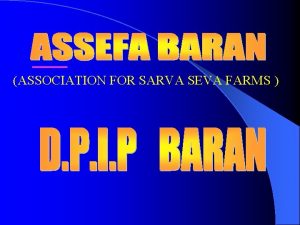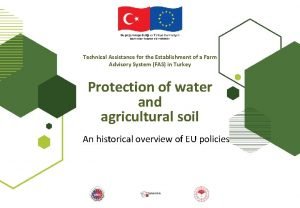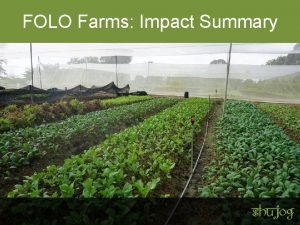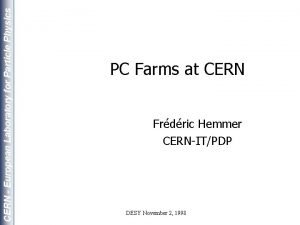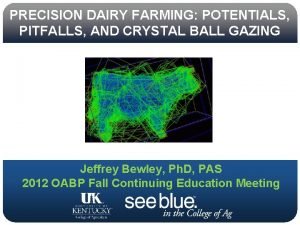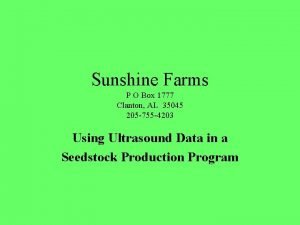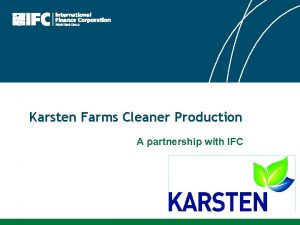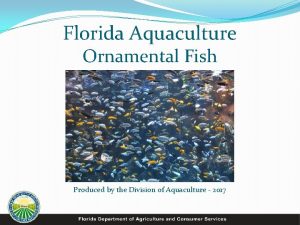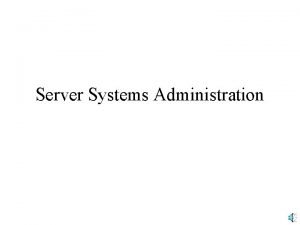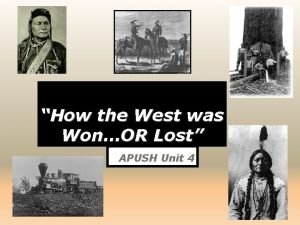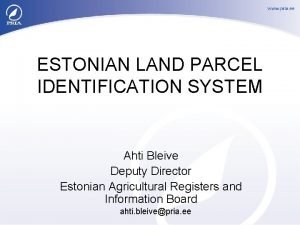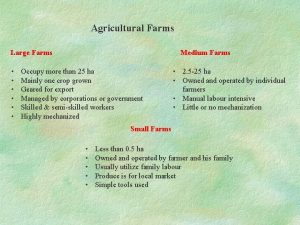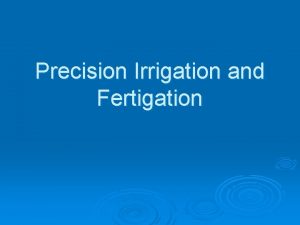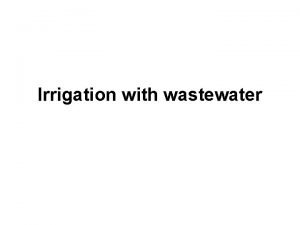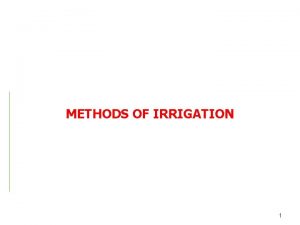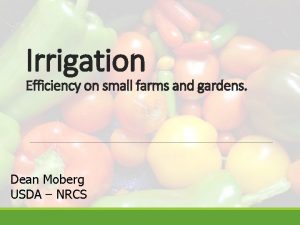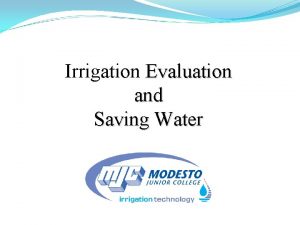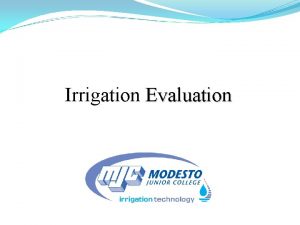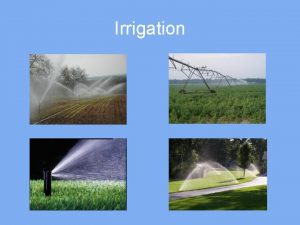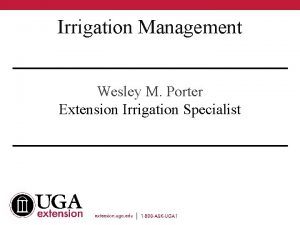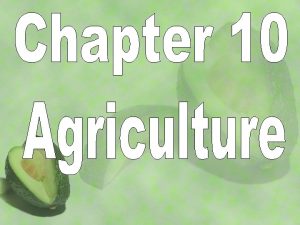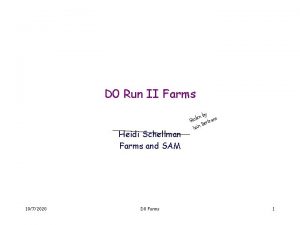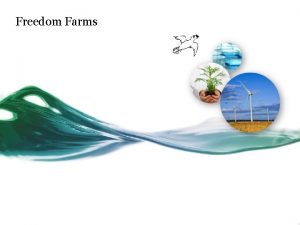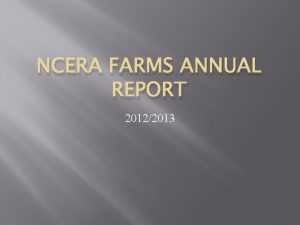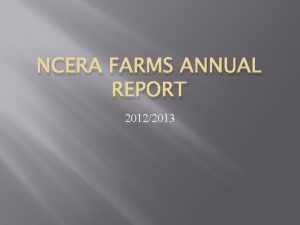Water Management and LowCost Irrigation for Small Farms




















































- Slides: 52

Water Management and Low-Cost Irrigation for Small Farms Dr. Godfrey Gayle North Carolina State A&T University

Overview of Presentation • Hydrologic/Water Cycle • Earth’s Water Balance and Distribution • Brief overview of predicted water shortage • Irrigation History • Soil Intake of Water • Simple design

Hydrologic Cycle One Concept

Earth’s Water Balance

Water Dist.

Earth’s Water Distribution Soil, Moisture, Atmospheric Biological 0. 1% LAKES, RIVERS, WETLANDS 0. 3% FIGURE 3 Adapted from Popular Science magazine, June 2007. As the population increases, the demand on dwindling available water sources will eventually outstrip the Earth’s ability to replenish supplies in lakes or underground aquifers

http: //ga. water. usgs. gov/edu/waterdistribution. html Distribution of Earth’s Water

Evolution of World Water Shortage Over 100 Years Obtained from Dr. R. W. Skaggs, NCSU

The Year 1950

The Year 2000

The Year 2025

The Year 2050

History of Irrigation • Cement pipes used by the Romans to convey water can be traced back to 2000 BC. • Irrigation can be traced back to about 6000 BC (Egypt and Mesopotamia). • Irrigation was used to cultivate Arid lands. • Drip used in Israel to produce crops on arid lands.

Some Irrigation Facts • Approximately 16% of farmland is irrigated. • Irrigated land is said to account for 40 -45% of production agriculture. • Over 70% of the water used on a global level is used for irrigation. • It is estimated that the irrigated acreage in the world is about 600, 000. • Water is required in sufficient amount for crop growth, yield, maintaining turgor and for cooling the plants.

Average Annual Cost for Small Drip Systems Using 8 -10 mil drip tape and plastic mulch the cost per acre can range between $480. 00 -$920. 00 BUT Before we irrigate, we must know about the soil to be planted and the crops to be grown.

Soils: Clay • Water moves in slowly • Water will stay in the soil for long time. • Clay soils hold the water for longer time than other soils • But may have runoff if the water is applied too fast

Soils: Sand • Water moves through quickly • Water does not stay in the soil for long as it does in clay soils. • Water goes in much deeper than in clay soil • Water will not spread as wide as in clay soil

Soils: Loam • Loam soil is good for plants • Water goes in at a moderate • Water stays in the soil for a longer time than sand but may be shorter than that of clay

Types of Irrigation Surface Irrigation – Water is applied to the ground by flowing out from the source as if by surface flooding Sprinkler Irrigation – Water is applied to the ground by spray. Water is applied from above like rain. Drip Irrigation – Water is applied in small amounts to the ground at the roots of plants. Water is applied at close to the rate that the soil will absorb it and the plants will use it.

Irrigation Efficiencies by Types Surface: Less than or equal to 50%. With reuse and good management this can increase Sprinkler or Overhead: 65 -85%. This can also be improved with good management. Drip/Trickle: 90 to 95%--Most efficient

Drip Irrigation Soil Test Before you set up a drip system, evaluate the soil with a simple test: Put a drip emitter unto a plastic bottle filled with water and allow it to flow for some time and observe soil intake rate.

Drip Irrigation Soil Test, continued • Determine how fast the water soaks into the ground. • Select a representative area and determine how the water spreads into/through the soil. • Think about how the plant will get and use the water.

Drip Irrigation Provides a specific amount of water to the plants Water is distributed through small openings called emitters

Drip Irrigation Setup

Mobile Water Tank

Simple Setup from a Standpipe

Drip System for Bigger Fields

Zone Valve for Small System

Drip Tape

Other Drip Systems • The emitters can be installed with a tube punch at the points where irrigation water is needed. • Emitters need to be closer on sandy soil. • There are many different types of emitters, some work at very low pressure.

Subsurface Drip Irrigation

Subsurface Drip Irrigation

Lateral Move System

Center Pivot or Lateral Move

Big Gun Hose/ Cable Pull System

Furrow Irrigation Surface System

System Design: Factors to Consider in Designing a Simple Drip System

Amount of Water to Apply • Amount per application depends on crop and soil properties • Know your soil: sand, silt, clay, loam • Know your crop water requirement/Evapotranspiration at critical growth stages in inch/acre or inch/day • Most crops, like vegetable crops, are comprised of 80 -90% water

To Select or Design an Irrigation System We Need to Know: • How much water is available and how good is its quality • How much water the plants will need • The critical periods the plants will need water • The slope of the field that we are going to irrigate • Types of soils in the field • The skills and availability of the persons who will do the irrigation

How to Determine Run Time and Amount of Water to Apply • If crop’s Et is 0. 20 then for an acre of land the crop will use 0. 20 x 27152 x 0. 50 =2715 gal (assuming you irrigate only where the crop is planted in this case 50% of the area; and knowing that 1 ac-in of soil contains about 27152 gal). • If you are using 4. 0 ft row spacing and a tape that drips at a rate of 0. 40 gpm/100 ft of tape length, the rate/hr will be: 0. 40 x 10890/100 = 44 gpm

Where Does the 10890 Come from? Acre = 43, 560 square feet Row width=4 feet 43, 560 4 feet 10, 890

Run Time and Amount Continue Starting Point: 44 gallons per minute (gpm) = 2, 640 gallons per hour Example: If I want to apply this amount of water: 2, 715 gal. I can divide it by 2, 640 gal/hr: To get the amount of time it will take: 2, 640 gal/hr. 1. 03 hours

Irrigation Scheduling • Feel the soil • Use rainfall amount as measured by gages • Use tensiometers • Know your crop and soil requirements A simple rain gage: a can on a stick

Sprinkler Disadvantages • Requires water that is under high pressure • Wastes water (evaporation and runoff loss) • Does not work well on clay soils (runoff) • Does not work well on steep slopes • Affected by wind • Cannot easily be automated • More weeds grow

Sprinkler Advantages • Less maintenance compared to drip • Less skill needed to operate • Problems are easy to detect • Can be used to cool the crop • Can be used to protect crop from frost • System components can be used for many years • System components more rugged than drip, can withstand abuse

Important Accessories Flow meter Pressure gauge Tensiometer


Atmometer These are used to estimate crop water use called evapotranspiration or Et.

Remember: No water = no yield! • If you do not plan to irrigate do not plant the crop! • Thanks for listening to this presentation

Contact Information Godfrey Gayle Professor Emeritus, Biological & Agricultural Engineer North Carolina A&T State University Greensboro, NC 27411 Phone: 336 -285 -4848 Email: gayle@ncat. edu

Other Places to Go for More Information Local Natural Resources Conservation Service (NRCS) Field Office NRCS Irrigation Guide http: //www. info. usda. gov/media/pdf/H_210_NEH_652. pdf USDA-NRCS Extension State Office

Acknowledgement Thanks to Ron Gronwald formerly of NRCS for his input.
 Water and water and water water
Water and water and water water Objectives of irrigation water management
Objectives of irrigation water management Objectives of irrigation
Objectives of irrigation Compare and contrast business organizations
Compare and contrast business organizations Electricity pros and cons
Electricity pros and cons What products came from the farms of italy gaul and spain
What products came from the farms of italy gaul and spain Potato irrigation management
Potato irrigation management Wilshire farms
Wilshire farms Ted hudson burnbrae farms
Ted hudson burnbrae farms Peterson farms loretto ky
Peterson farms loretto ky Seva farms
Seva farms Kiwiw farms
Kiwiw farms Redmere farms
Redmere farms Folo farm
Folo farm Jolivette family farms
Jolivette family farms Jenson farms v. cargill
Jenson farms v. cargill Pc farms
Pc farms Mastiline
Mastiline Amli at danada farms
Amli at danada farms Sunshine farms
Sunshine farms Karsten farms
Karsten farms Imagination farms
Imagination farms Ornamental fish culture
Ornamental fish culture Wilson beef farms canaseraga ny
Wilson beef farms canaseraga ny Small servers
Small servers Seeland farms
Seeland farms David sackett growth farms
David sackett growth farms Custer's last stand apush
Custer's last stand apush Ahti bleive
Ahti bleive Love apple farms
Love apple farms Iso 22301 utbildning
Iso 22301 utbildning Typiska drag för en novell
Typiska drag för en novell Nationell inriktning för artificiell intelligens
Nationell inriktning för artificiell intelligens Returpilarna
Returpilarna Varför kallas perioden 1918-1939 för mellankrigstiden?
Varför kallas perioden 1918-1939 för mellankrigstiden? En lathund för arbete med kontinuitetshantering
En lathund för arbete med kontinuitetshantering Personalliggare bygg undantag
Personalliggare bygg undantag Tidbok yrkesförare
Tidbok yrkesförare Anatomi organ reproduksi
Anatomi organ reproduksi Förklara densitet för barn
Förklara densitet för barn Datorkunskap för nybörjare
Datorkunskap för nybörjare Boverket ka
Boverket ka Hur skriver man en tes
Hur skriver man en tes Delegerande ledarstil
Delegerande ledarstil Nyckelkompetenser för livslångt lärande
Nyckelkompetenser för livslångt lärande Påbyggnader för flakfordon
Påbyggnader för flakfordon Tryck formel
Tryck formel Publik sektor
Publik sektor Jag har nigit för nymånens skära text
Jag har nigit för nymånens skära text Presentera för publik crossboss
Presentera för publik crossboss Vad är ett minoritetsspråk
Vad är ett minoritetsspråk Vem räknas som jude
Vem räknas som jude Klassificeringsstruktur för kommunala verksamheter
Klassificeringsstruktur för kommunala verksamheter

